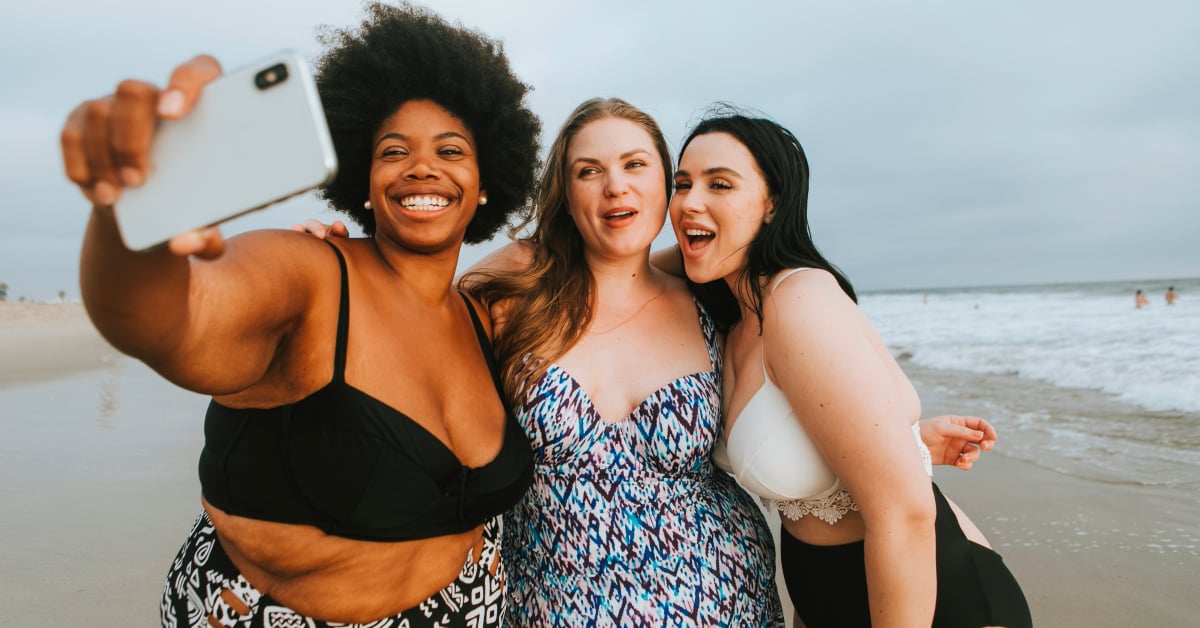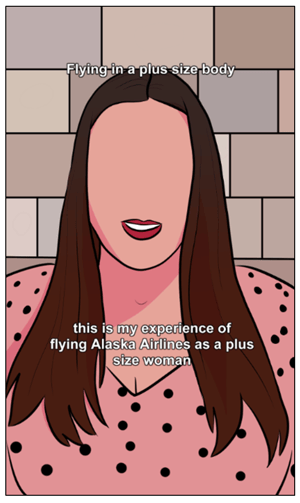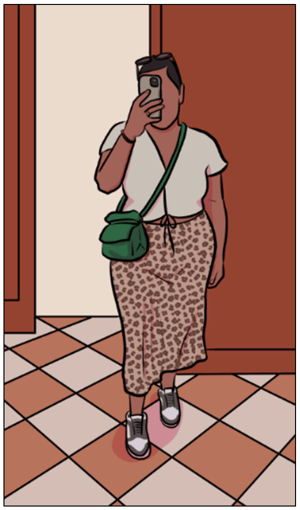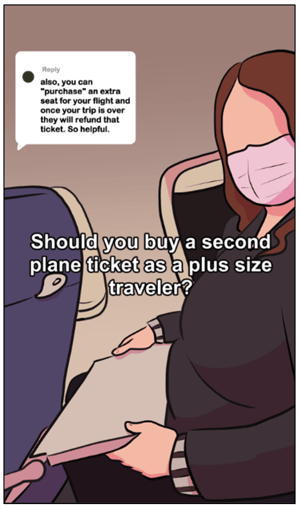How TikTok is making travel more body inclusive
16 June 2025 | By: Dr Weizheng Zhang | 7 min read
Travel is most often portrayed in the media through a narrow lens of idealised body types.
But by analysing the videos created by TikTok content creators and the comments by viewers, our new research explores how digital platforms are reshaping perceptions of who gets to be an empowered tourist, and how this shift is creating a more inclusive and body-positive narrative.
Contents:
- Why does size matter in travel?
- Holiday destinations as social constructs
- What is the 'tourist body'?
- Digital platforms as spaces of plus-sized empowerment
- Community, visibility, and emotional support
- Digital storytelling as social activism
- Ongoing challenges: negativity and harassment
- A call for industry accountability and inclusive tourism
Why does size matter in travel?
In a world where glossy brochures, airline adverts, and travel influencers often present a narrow vision of the ideal tourist, our new study – ‘Plus size people can and will travel too: body positivity in travel and leisure’ (2025) – explores the identity of travel destinations and begins to redefine what it means to be a traveller. Most specifically, a plus-size traveller.
A collaboration between experts at the Newcastle University Business School, University of Essex, University of Surrey, and a Psychological Insights expert, our study, published in the Journal of Sustainable Tourism, first explores the representation of tourism as a form of embodied social practice, before providing an understanding of social media posts as a form of social resistance. Our findings spotlight how TikTok is becoming a powerful space for larger-bodied people to challenge stereotypes, foster community, and advocate for inclusive and sustainable tourism that represents all, not just the few.
Holiday destinations as social constructs
Travel and leisure spaces are not merely physical locations, but socially constructed environments actively shaped and reinforced by power dynamics, social identities, and cultural meaning[1].
Tourism marketing and social media shape perceptions of who belongs in these spaces and who does not.
While recent research has begun to explore a range of diverse tourist identities – such as LGBTQIA+ travellers and gender non-conforming youth[2] – the lived experiences of plus-size tourists remain comparatively under-researched. Our study addresses that gap and calls for the industry to consider how physical environments and promotional materials either include or exclude based on body size.
What is the 'tourist body'?
Tourism plays a huge role in constructing the ‘tourist body’. This concept depicts tourists based heavily on aesthetic and normative ideals. This archetype, typically slim, youthful, and able-bodied, is used to signify desirability and mobility – qualities that have historically excluded diverse body types from tourism marketing and representation[3].
Often portrayed in sexualised and overtly visible positions, the ‘tourist body’ is a crucial advertisement for the desirability of a place or destination. Regularly showcasing this conventional ‘tourist body’ promotes an individualised tourism physicality that problematises alternative body types, such as plus-size travellers [4].
Yet, these idealised images fail to reflect the demographic reality.
These alternative body types make up a significant proportion of travellers. While the figures on plus-size travel and leisure trends are limited, in 2016, 39% (+1.9 billion) of adults aged 18 years and over were overweight, and 13% (650 million) were obese[5]. Specifically, the most recent 2016–2017 report on the UK plus-size market suggests that an estimated 63% of people were ‘overweight’[6], while more than 73% of the US adult population was considered overweight or obese during this same period[7] .
So, where is the representation for this segment?
Digital platforms as spaces of plus-sized empowerment
While tourism marketing has long been steeped in ableist and image-focused ideals, our findings show that these norms are being actively resisted by plus-size content creators who craft new narratives centred on authenticity and lived experience.
Our research analysed 200 TikTok videos and nearly 1,000 viewer comments to examine how plus-size travel content creators are engaging with and challenging dominant tourism narratives. They did this by not only highlighting barriers, but by providing travel suggestions and recommendations for plus-size travellers and tourism service providers. These videos are non-sponsored, so are not for advertising or other commercial purposes. These videos often focus on the logistics of travel, such as fitting into plane seats or accessing hotel amenities, but they also create emotional and psychological empowerment.
Whilst theme park and restaurant seat/table constraints and challenges are occasionally discussed, approximately 44% of TikTok’s shared experiences detailed by creators consisted of flight-related encounters, particularly low-cost carriers’ small economy seats. Speaking directly to the audience, one content creator reflects on their experience flying as a plus-size woman with Alaska Airlines and their challenge with the seat’s armrests, sharing (Figure 1):

FIG.1 Flying in a plus-size body.
‘We were the first row behind first class. I didn’t realise because there was no indication when we were booking that the seats, we were sitting in didn’t have adjustable armrests. When we sat down in these seats, I was overwhelmingly surprised that I barely fit in the seats ... I honestly felt like I couldn’t breathe. My whole body was like [as] tense and I was making myself as small as I could, and it was really, really physically uncomfortable ... Out of disbelief and anger and frustration and sadness and discomfort and pain I just started crying ...’
In cases such as this, TikTok acts as both a confessional and an educational space. Content creators raise awareness of systemic issues, while viewers validate shared experiences and propose community-informed solutions.
Community, visibility, and emotional support
One theme that emerged in the study was the cultivation of community. Comment sections on TikTok videos became a hub for mutual support, reassurance, and emotional validation.
Viewers shared their own stories, offered encouragement, and reinforced the sense that travel is – and should be – for everyone. This sense of digital solidarity demonstrates how visibility alone can disrupt exclusion and foster empowerment.
Responses of acknowledgement and understanding to Fig.1 were shared by two comments:
'... I also have been bruised by airplane seats'. V52-C4
'Girl, I’ve been in that exact same seat, same airline, same flight…I have INTENSE anxiety on that flight'. V52-C5
This sense of community extends further into playful and engaging ‘travel hacks’, ‘outfit of the day’ (OOTD), and ‘try on’ videos, a cultural phenomenon in the context of fashion blogging and vlogging. Approximately 18 out of 200 TikTok videos deliberately offered a 'plus-size fit check', focusing on travel apparel and confidently sharing fit support and suggestions. Such material subverts the conventional association of travel aesthetics with thinness, and instead promotes visibility, self-acceptance, and joy.

FIG.3 Mirror selfie (V62).
Importantly, OOTD and 'try on' content that serves to enhance interactivity, authenticity, and trustworthiness often received encouraging and complementary responses from TikTok audience members as the following excerpts indicate:
'Finally someone with the same body type as me doing a try on! I LOVE them on you girly. So gorgeous' (V17-C4)
'You look so good mama ... I appreciate these outfits' (V62-C1)
'Thank you for this video! I’m [sic] a size 22/24 & this inspired a couple cruise outfits for me that [sic] normally wouldn’t have even tried’ (V110-C2)
The digital sharing of plus-size travel hacks, reviews, and suggestions emphasises the crucial role of authentic, personalised user-generated content in shaping consumer perceptions and increasing confidence. These interactions between content creators and audience members reflect a symbiotic relationship, where influencers provide insights and audiences routinely engage with constructed content by requesting more personalised information to enhance or improve their travel and leisure experiences.
Digital storytelling as social activism
There is some evidence to suggest that the use of storytelling in short-form videos also prompts reflection and action among industry stakeholders.
Showcasing structural constraints and limitations of standardised airline seats, another content creator recalls an experience of flying with Southwest Airways, highlighting the airline’s plus-size friendly policy, which offers reimbursement for a second seat when the flight has not reached full capacity.
The positive and favourable emotions conveyed in the video resonated with the audience, evident by the top five comments expressing encouragement and the perception of viable solutions for plus-size travel, including the second seat refund policy. Engaging with the content and confirming the policy, V72-C2 shared:

FIG.2 Airline seat constraints.
Current airline 'Customer of Size' policies address seat size issues and requirements for plus-size passengers, highlighting the structural inadequacies, inconsistencies, and the sector's lack of accessibility. Without policies like Southwest Airways’, current industry practices, such as the necessary purchase of extra seats to accommodate physically larger bodies, may be viewed as a discriminatory practice, one which adds additional financial strain and further excludes plus-size travellers from participating fully in the holiday experience[8].
Ongoing challenges: negativity and harassment
However, while the content shared on TikTok conveys messages of empowerment and self-acceptance, body-positive content was still subject to body surveillance through forms of criticism, confrontation, and harassment. Despite TikTok content creators’ efforts to reclaim the term ‘fat’ through visibility and positive discourse, criticisms and detracting remarks continually undermined these efforts by shaming and stigmatising plus-size tourist bodies.
If the plus-size tourist body is an act of rebellion, then it can also be identified as a societal threat. This threat then challenges the idea of categorising people into groups, and the hierarchical opposition between the valued dominant and devalued subservient subjects [9]. Some viewers reinforced societal norms by shaming creators and calling for conformity to mainstream body ideals. This form of body surveillance reasserts exclusionary binaries between ‘acceptable’ and ‘unacceptable’ tourist bodies [9][10].
Importantly, it suggests that anyone who does not control their body size is entitled to less figurative and literal space [11]. Therefore, the burden of ‘fitting in’ is placed on the individual rather than the industry, reinforcing structural discrimination and diminishing the potential for inclusive tourism.
A call for industry accountability and inclusive tourism
This research highlights a quiet revolution by TikTok video creators. A revolution led not by institutions, but by real people who are claiming space, telling stories, and changing minds.
And while some movement has been seen in the industry, more also needs to be done by the wider tourism industry to commit to authentic, structural change. This includes rethinking accessibility, redesigning infrastructure, actively representing diverse bodies in marketing materials, and engaging with feedback from plus-sized travellers. Doing so is not only an ethical imperative - it is also a commercially viable strategy for engaging a broader consumer base.
Moreover, in identifying the imbalances of representation, our research also calls for the travel industry to reimagine its approach to accessibility, representation, and equality.
You might also like
- read the full study: 'Plus size people can and will travel too: body positivity in travel and leisure'
- Authors: Whitney Estanita Vernes, Weizheng Zhang, Albert N. Kimbu, and Paul Hanna, Journal of Sustainable Tourism, 2025
- read the press release: 'Travel industry must accept plus-size tourists "can and will travel"'
- writing for The Conversation, Dr Weizheng Zhang and Dr Whitney Vernes discuss four ways that plus-sized travellers can feel empowered this summer
- find out more about the authors:
- Dr Weizheng Zhang, Lecturer in Marketing at Newcastle University Business School
- Dr Whitney Estanita Vernes, Lecturer in Tourism at the University of Essex
- Albert Nsom Kimbu, Professor at University of Surrey (UK) & Senior Research Associate at University of Johannesburg (South Africa)
- Paul Hanna, Psychological Insights Lead, Associate Director at Hoare Lea
- explore the wide range of research carried out by the Newcastle University Business School
Examples and quotes in this study are based on publicly available content from TikTok. The illustrated figures are based on images from TikTokers but have been anonymised, with no identifiable facial features shown. The full details of all quotes and figures of this research can be found in the full study.
References:
Browse the full list of references in the expanded study.
- Aitchison, C., & Reeves, F. (1998). Gendered(bed) spaces. In C. Aitchison & F. Jordan (Eds.), Gender, space and identity. Leisure Studies Association.
- Reddy-Best, K. L., & Olson, E. (2020). Trans traveling and embodied practices: Panopticism, agency, dress and gendered surveillance. Annals of Tourism Research, 85, 103028
- Benjamin, S., & Dillette, A. K. (2021). Black travel movement: Systemic racism information tourism. Annals of Tourism Research, 88, 103169
- Jordan, F. (2007). Life’s a beach and then we diet: Discourses of tourism and the ‘beach body’ in UK women’s lifestyle magazines. In A. Pritchard, N. Morgan, I. Ateljevic, & C. Harris (Eds.), Tourism and gender: Embodiment, sensuality and experience. CABI Publishing.
- WHO. (2021). Obesity and overweight.
- PwC. (2017). The UK plus size clothing market review
- CDC. (n.d). Obesity and overweight.
- Andrews, H. (2011). The British on holiday. Channel View Publications.
- Johnston, L. (2001). (Other) bodies and tourism studies. Annals of Tourism Research, 28(1), 180–201
- Huff, J. L. (2009). Access to the sky: Airplane seats and fat bodies as contested spaces. In E. Rothblum & S. Solovay (Eds.), The fat studies reader. New York University Press.
- Farrell, A. E. (2011). Fat shame. New York University Press.
